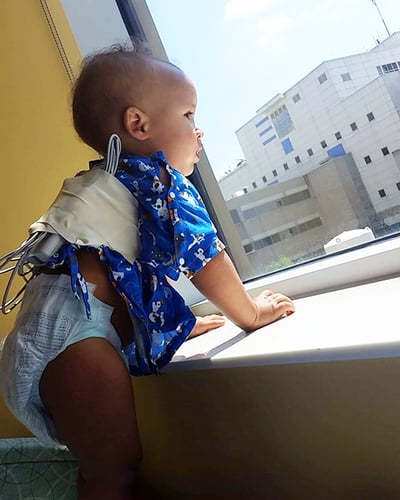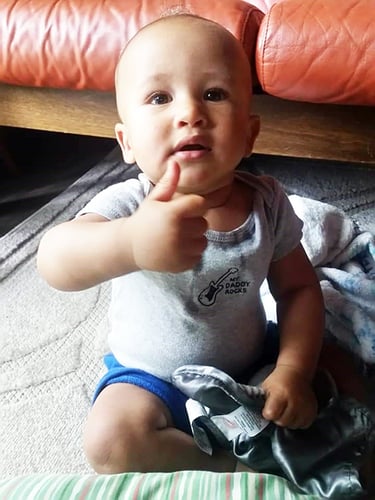
Heart of a champion: The story of Ezekiel, the miracle mystery baby
Imagine a marathon runner crossing the finish line. They’re in peak physical condition — having spent the last several months training — and for more than four hours they’ve been running, uninterrupted, for 26.2 miles. Their body is soaked with sweat, their chest heaving and heart pounding so fast and deep it vibrates throughout their body. They rest for a moment, their hands on their knees, allowing their body to collect itself.
Now imagine that runner is a 1-year-old baby. And as soon as he finishes that first marathon, he runs another one. Then another one. Then another one. Over and over again without rest. That’s what has been going on with baby Ezekiel’s heart.
 Ezekiel’s mom, Jennifer, remembers the day when she first noticed something. June 22, 2020. He was 8 months old at the time and she was snuggling him as he napped. He was as happy and peaceful as any little sleeping baby. There was no reason whatsoever to suspect anything was amiss.
Ezekiel’s mom, Jennifer, remembers the day when she first noticed something. June 22, 2020. He was 8 months old at the time and she was snuggling him as he napped. He was as happy and peaceful as any little sleeping baby. There was no reason whatsoever to suspect anything was amiss.
But as she was holding him on her lap, she suddenly noticed his heartbeat. It seemed fast, and she thought it was somewhat odd that she could feel it so prominently. Her husband, Faulkner, said they should take him to the doctor, but Jennifer wasn’t so sure.
“What am I going to tell the doctor, that I can feel his heart?” said Jennifer. “He was acting perfectly normal.”
Ultimately, they decided it couldn’t hurt and so after Ezekiel woke from his nap around 4:30 p.m., Jennifer took him to an urgent care near their home in Oshkosh, Wisconsin. Still, she felt a little silly being there.
“Finally, we went in,” said Jennifer. "I told the nurse, ‘It’s fine if you want to send me home. I can feel his heart, and my husband wants me to check it, so we’re checking it.’”
But things quickly changed when the doctor listened to Ezekiel’s heart. He only listened for a moment before he removed the stethoscope and leaned back in his chair. He paused briefly, collecting his thoughts, and then told Jennifer he was calling an ambulance to take Ezekiel to a nearby emergency room.
Confused and now concerned, Jennifer told the doctor that the ER was only a few minutes away and she could easily drive him herself.
But the doctor replied, “I don’t know if he’s going to make it.”
The start of a long journey
 Sitting in that small exam room, the doctor’s dire declaration hung heavily.
Sitting in that small exam room, the doctor’s dire declaration hung heavily.
I don’t know if he’s going to make it.
Jennifer, at first, thought he was joking. But as they waited for the ambulance to get ready, the doctor hooked Ezekiel up to an EKG to measure his heart rate. A normal rate for a kid his age is around 100 beats per minute.
Ezekiel’s was 360.
“Ezekiel is sitting in my lap, laughing and talking and being normal,” said Jennifer. “But the monitor he’s hooked up to keeps flashing and beeping and zeroing out.”
By the time they got to the ER, it was around 8 p.m. After examining Ezekiel, the ER doctor called Anoop Singh, MB BCh, program director of cardiac electrophysiology at the Herma Heart Institute at Children’s Wisconsin. Dr. Singh made some treatment recommendations to get Ezekiel stabilized and made arrangements to get him to Children’s Wisconsin Hospital-Milwaukee as soon as possible.
The ER doctor gave Ezekiel adenosine, a medication designed to help the heart restart itself. One dose normally works, but after receiving three doses Ezekiel’s heart had not responded at all. Although he remained stable, Dr. Singh wanted to see Ezekiel right away and sent a transport team to bring him to Milwaukee. By the time they got to Children’s Wisconsin, it was 5 a.m., and Ezekiel was immediately admitted to the pediatric intensive care unit (PICU).
“I got there shortly after he arrived and what I remember is just a little bit of disbelief,” said Dr. Singh, who is also an associate professor of pediatric cardiology at the Medical College of Wisconsin. “I didn’t think it was possible for someone’s heart to go that fast and still be sitting there in his mother’s lap.”
Ezekiel was diagnosed with ventricular tachycardia (VT), a rapid heartbeat caused by a malfunction in the heart’s electrical system. When the heart beats so fast, the chambers of the heart aren’t able to fill completely with blood. As a result, there is not enough blood available to be pumped throughout the body and lungs. With his heart pumping that fast for that long, Ezekiel would be at high-risk for heart failure if not corrected.
While VT in children is rare, what makes Ezekiel’s case particularly unique is his lack of symptoms. Normally, a person with VT would be experiencing dizziness, chest pain, shortness of breath or loss of consciousness, all placing them at risk for a cardiac arrest. But Ezekiel has never displayed any outward symptoms whatsoever. His heart will be racing at more than 300 beats per minute and he’ll be playing, smiling, laughing without a care in the world.
The miracle mystery baby
 Now at the Herma Heart Institute at Children’s Wisconsin, Ezekiel was under the care of some of the best pediatric heart experts in the world. But even for them, he was a challenge the likes of which they had never seen.
Now at the Herma Heart Institute at Children’s Wisconsin, Ezekiel was under the care of some of the best pediatric heart experts in the world. But even for them, he was a challenge the likes of which they had never seen.
“They called him the miracle mystery baby,” said Jennifer with a smile.
Since that day in June, it’s been an exhausting series of starts and stops. He’s come to the hospital, been stabilized and sent home, only to have another episode and be readmitted. His first hospital stay in June lasted six days. He went home for about a month before he was back. After a couple days in the hospital, he stabilized and was discharged. But, again, a couple weeks later he was back in the hospital. After a few days he was discharged, but this time before he even got home he had another episode and was readmitted for another 20 days. That was followed by another month home, another 20 days in the hospital.
“It was definitely a rollercoaster. It was a very scary time,” said Jennifer. “I’m so thankful for the staff at Children's Wisconsin who became like family. The love they show him, it’s incredible. Nurse Erik and all the other nurses and doctors are so caring. They love each child and it gives me comfort to know he’s in such good hands.”
During these stays, Dr. Singh and his team worked to find the right combination of medications to help keep Ezekiel's heart rate under control, carefully monitoring him to see how he responded, and adjusting as necessary. Dr. Singh consulted with fellow pediatric heart rhythm experts at health systems across the country. They were all stumped.
“Ventricular tachycardia is predominantly seen in older patients. There are reports in infants, but no one’s described a stable patient with a heart rate of 360,” said Dr. Singh. “In speaking with my colleagues in electrophysiology, no one’s seen this before.”
So much of Ezekiel’s first year of life was spent in the halls of the Children’s Wisconsin’s cardiac intensive care unit — he learned to wave and clap, he took his first steps, he celebrated his 1st birthday — that he became something of a celebrity on the floor. During his long stays, Ezekiel would wander the halls, playing with staff and saying hi to fellow patients.
 “Zeke brought joy to so many people in the ICU. There was a little girl next door, around 3 years old, who was born with half a heart. She would light up whenever he passed the room,” said Jennifer. “There were two other little friends that would always smile when Zeke came around. When he heard kids crying, he would makes noises back at them, like he was telling them it will be okay. He brought great joy to the staff and families around the ICU. He was motivation for other patients.”
“Zeke brought joy to so many people in the ICU. There was a little girl next door, around 3 years old, who was born with half a heart. She would light up whenever he passed the room,” said Jennifer. “There were two other little friends that would always smile when Zeke came around. When he heard kids crying, he would makes noises back at them, like he was telling them it will be okay. He brought great joy to the staff and families around the ICU. He was motivation for other patients.”
One day, Jennifer received the following message from a fellow mom: “Oh melt my heart big guy!!!!! He's such a ray of sunshine for so many people! I am so hopeful the doctors find a plan that works to get you guys home! But I know in the meantime he’s making some very hard times for families a little bit easier! He especially did for us! Sending lots and lots of prayers!!"
Of course, while he was in the hospital, he was supposed to be in bed being monitored. But that’s easier said than done for an active toddler who is full of life and energy. So, Dr. Singh and his team had to get creative.
“It was just so hard to keep him in his bed,” said Dr. Singh. “I’m not sure which nurse came up with the idea, but they came up with a way to put the sensors on him and strap the monitor to his back so he couldn’t reach it. It worked great. We called it his jet pack.”
Spending so much time away from home and family can be incredibly difficult — making that nearly 90 minute drive to the hospital just about every month, not knowing what fate awaited your baby, all while caring for three other young, active boys at home. But Jennifer and Faulkner chose to focus on the positive and practiced patience.
“Everybody wants answers now, everyone wants things done right away. But in this situation, we know they’re doing what they need to do,” said Jennifer. “I just thank them for not giving up on him. I’m so thankful that the doctors want to make sure he’s safe and make sure they handle it the right way. We’re not in a hurry.”
The great unknown
 When Ezekiel was able to go home, his care team kept close tabs on him. He was fitted with a portable heart rhythm monitor that synced with his mom’s cell phone and sent daily updates to his care team — another creative solution Dr. Singh and his team came up with for their mystery baby. This device — a small rectangular sensor about the size of a stick of gum — was designed for adults to place their fingers on the two pads to track their heart’s rhythm. But Dr. Singh and his team discovered it also worked when placed directly on Ezekiel’s chest.
When Ezekiel was able to go home, his care team kept close tabs on him. He was fitted with a portable heart rhythm monitor that synced with his mom’s cell phone and sent daily updates to his care team — another creative solution Dr. Singh and his team came up with for their mystery baby. This device — a small rectangular sensor about the size of a stick of gum — was designed for adults to place their fingers on the two pads to track their heart’s rhythm. But Dr. Singh and his team discovered it also worked when placed directly on Ezekiel’s chest.
“We’ve never used it in this way before, it’s a pretty novel thing,” said Dr. Singh. “His mother would send us readings two or three times a day and we were able to see how he was doing and make sure his heartbeat wasn’t getting too fast. And, he still brightens my team’s day whenever Jennifer throws in a cute picture of Ezekiel with the daily rhythm update email.”
“It's been so wonderful to have the device that Dr. Singh gave us,” said Jennifer. “We are able to monitor him and that gave us peace of mind moving forward.”
Since his last discharge on Oct. 20, four months ago and counting, Ezekiel has remained stable and at home. But looking forward, he’ll ultimately need a catheter ablation. In this procedure, a small incision is made in the groin and a thin tube is inserted into a blood vessel and fed up to the heart. Then, either with extreme heat or cold, the malfunctioning spot of his heart is cauterized so it no longer is able to send the faulty electrical signals. But that’s years down the line — right now, his blood vessels and heart are simply too small.
But for now, Jennifer and Faulkner are just focused on today.
“I'm so thankful to have Dr. Singh and his team as part of our journey. It's been a long road, but it's just the beginning. It was bumpy at first, but because of the team at Children's Wisconsin, our journey is less hilly now. We’re not sure what the future will hold, but with the Singh team in our corner, we are ready for the fight,” said Jennifer. “We are just so lucky and so blessed. I know we’re going to be a success story.”
Children's Wisconsin Resources

Written by
Evan Solochek
Writer
Related Stories
No related articles found.



